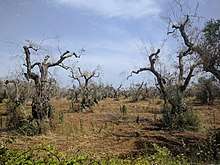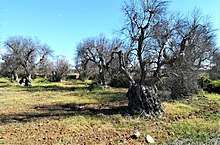Olive quick decline syndrome
Olive quick decline syndrome (OQDS) (in Italian: Complesso da Disseccamento Rapido dell'Olivo, CDRO or CoDiRo) is a wasting disease of olive trees which causes dieback of the leaves, twigs and branches so that the trees no longer produce crops of olives. The main cause is a strain of the bacterium, Xylella fastidiosa, which is spread by plant-sucking insects such as the meadow froghopper. The bacteria restrict the flow of sap within the tree and so choke its extremities.[1]
| Olive quick decline syndrome | |
|---|---|
 An olive grove infested with Xylella fastidiosa in Puglia, Italy in 2019 | |
| Common names | OQDS |
| Causal agents | Xylella fastidiosa |
| Hosts | Olive trees |
| Vectors | Meadow froghopper |
| Distribution | Southern Italy |
| Symptoms | Dieback of the leaves, twigs and branches |

Impact
The disease is particularly affecting olive groves in Southern Italy. It was first detected in Italy in 2013[2], in the Salento Peninsula; by late 2013, it was estimated that approximately 8,000 hectares were affected.[3] The disease currently threatens olive groves and oil production in Italy, Greece, and Spain, which together account for 95% of European oil production[4][5] One 2020 model predicts a potential economic impact of the disease for Italy over 50 years between 1.9 billion to 5.6 billion Euros.[4]
In addition to Europe, the disease has also been detected in olive crops in California, Argentina and Brazil.[6]
Symptoms
Symptoms include leaf scorch and desiccation of twigs and branches, beginning at the upper part of the crown and then moving to the rest of the tree, which acquires a burned look[7].
References
- Olive Quick Decline Syndrome (PDF), Primary Industries and Regions SA, 2017
- Stokstad, Erik (8 May 2015). "Italy's olives under siege". Science. 348 (6235): 620–620. doi:10.1126/science.348.6235.620. ISSN 0036-8075. PMID 25953988.
- Martelli, Giovanni P. (1 February 2016). "The current status of the quick decline syndrome of olive in southern Italy". Phytoparasitica. 44 (1): 1–10. doi:10.1007/s12600-015-0498-6. ISSN 1876-7184.
- Schneider, Kevin; Werf, Wopke van der; Cendoya, Martina; Mourits, Monique; Navas-Cortés, Juan A.; Vicent, Antonio; Lansink, Alfons Oude (28 April 2020). "Impact of Xylella fastidiosa subspecies pauca in European olives". Proceedings of the National Academy of Sciences. 117 (17): 9250–9259. doi:10.1073/pnas.1912206117. ISSN 0027-8424. PMID 32284411.
- McGrath, Matt (13 April 2020). "Deadly olive tree disease 'could cost billions'". BBC News. Retrieved 5 May 2020.
- Saponari, M.; Boscia, D.; Altamura, G.; Loconsole, G.; Zicca, S.; D’Attoma, G.; Morelli, M.; Palmisano, F.; Saponari, A.; Tavano, D.; Savino, V. N. (18 December 2017). "Isolation and pathogenicity of Xylella fastidiosa associated to the olive quick decline syndrome in southern Italy". Scientific Reports. 7 (1): 1–13. doi:10.1038/s41598-017-17957-z. ISSN 2045-2322.
- Martelli, G. P.; Boscia, D.; Porcelli, F.; Saponari, M. (1 February 2016). "The olive quick decline syndrome in south-east Italy: a threatening phytosanitary emergency". European Journal of Plant Pathology. 144 (2): 235–243. doi:10.1007/s10658-015-0784-7. ISSN 1573-8469.